Abstract
Background:
Community pharmacies are now frequently being visited by customers/patients to seek oral advice. Malaysian community pharmacists are also found to be experiencing an increased demand of oral health advices by their visiting customers.
Aims/Objectives:
The aim of the study was to explore the knowledge, attitude, and practice of the final year Bachelor of Pharmacy students in a private university toward oral health, as these students will be the future pharmacists.
Materials and Methods:
This cross-sectional study was carried out among final year undergraduate pharmacy students by using self-administered questionnaire. It was conducted as a classroom survey. Raosoft software was used to determine the minimum required sample size.
Results:
The demographic distribution of the respondents was separated into gender, ethnicity, and state of origin. Over 83.8% of the participants were females, with Chinese ethnicity dominating (78.4%) compared to others, and the distribution showed 11 different states of origin.
Conclusions:
This research finding shows that pharmacy students have positive attitude toward oral health despite having poor knowledge and mediocre practice principles regarding oral health.
Keywords: Cross-sectional study, knowledge, oral health, oral hygiene, pharmacist, pharmacy students
INTRODUCTION
The role of pharmacists has expanded and evolved with time and is not restricted to only dispensing medication to customers or patients.[1] Pharmacists are now an important member of the primary healthcare team and hold a great potential to expand their role in oral health promotion.[2,3,4,5,6,7] Consistent with many other studies, the Malaysian community pharmacists are also found to be experiencing an increased demand of oral health advices by their visiting customers.[8]
Community pharmacies are now frequently being visited by customers/patients to seek oral advice.[9] At least one question per week regarding oral health is being asked to the pharmacists according to a survey done by Iwanowickz[10] in Edinburg, Scotland, and over 11 questions per week are asked according to a survey in North England.[5] They are often the first “port of call” or “point of contact” for the public, whether to seek general health advices or oral health advices.[3,11] This is also due to the long opening hours of the pharmacies.[12] In fact, with a large number of customers visiting, the pharmacists actually come into contact with more people with dental problems than an average dentist does.[9,13] We have to understand that community pharmacies are a setting for the general public who cannot attend dental care to consult for dental advices.[1,11] Costs and accessibility are among the reasons that prevent general public from having proper dental care.[14]
Based on these reports, it is obvious that pharmacists play an important role in oral health promotion. Therefore, we aimed to carry out this study to explore the knowledge, attitude, and practice of the final year Bachelor of Pharmacy (B. Pharm) students in a private university in Malaysia toward oral health, as these students will be the future pharmacists.
MATERIALS AND METHODS
Study setting
This cross-sectional study was carried out among final-year undergraduate pharmacy students by using self-administered questionnaire. It was conducted as a classroom survey. Prior approval was obtained from the concerned university. During the data collection phase, researchers approached the cohort of final year pharmacy students to provide information about the study and obtained written informed consent before distributing the questionnaires to the students. Raosoft software was used to determine the minimum required sample size. Based on the calculation with 5% margin of error, 95% confidence level, and 50% response distribution, at least 68 students were needed out of a total of 130 students involved. By the end of data collection phase, 74 completed questionnaires were collected from the participants.
Sampling
Convenience non-probability sampling technique was used in this study. This method was used to select subjects because of their convenient accessibility and proximity to the researchers. Students who had given their written informed consent were included in this study. Students who were unable to give their consent, who had barrier in communication, and who were not interested to participate were excluded from this study.
Ethical approval
This study was approved by the International Medical University Joint-Committee of the Research and Ethics Committee.
Designing the questionnaire
A questionnaire was designed after a detailed review of relevant literature. It was written in English, as the medium of instruction in Malaysian universities is English. Demographic data such as age, gender, state, and ethnicity were collected. The questionnaire consisted of three sections with 16 questions. Six questions evaluated the knowledge, five questions evaluated the attitude, and another five questions evaluated the practice toward oral health.
Validation of questionnaire
A pilot study was done on twenty final year pharmacy students to validate the questionnaire. Cronbach's alpha test was used to assess the reliability. The questionnaire was found to have a reliability coefficient of 0.74.
Data analysis
Descriptive and inferential data analyses were carried out using SPSS version 20. The variables for testing knowledge questions were dichotomized. The right option was assigned 1, whereas the wrong option was given 2. Frequency and percentage of pharmacy students with right and wrong responses were then obtained. Correlation bivariate test was performed to find the relationship between pharmacy students’ knowledge, attitude, and practice toward oral health.
The variables for testing attitude and practice of pharmacy students were graded on a four-point scale [Figures 1 and 2]. For the attitude section, the response was assigned 1, 2, 3, or 4, where 1 was the best response and 4 the worst response. During the analysis, 1 and 2 were combined as the right/positive response and 3 and 4 as the wrong/negative response. The frequency and percentage of pharmacy students with positive and negative attitudes toward oral health were obtained during the analysis.
Figure 1.
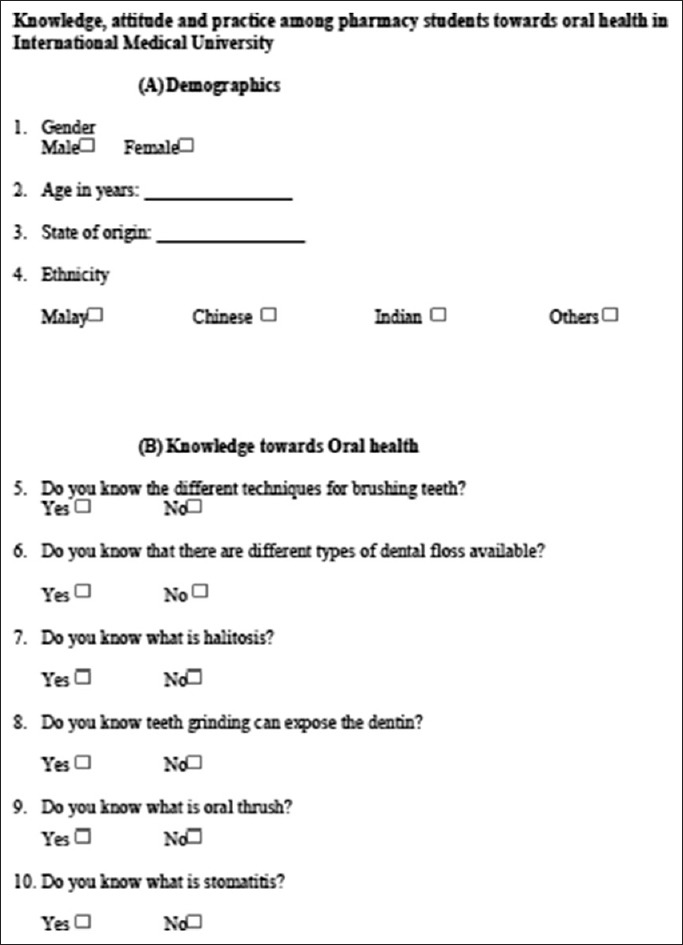
The questionnaire used for collecting data on demographics and knowledge among pharmacists toward oral health
Figure 2.
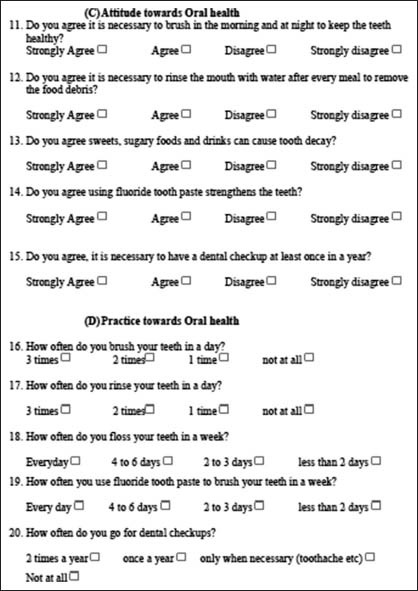
The questionnaire used for collecting data on attitude and practice of pharmacists toward oral health
The practice section was similar to the attitude section, where the response was assigned 1, 2, 3, or 4. In this, 1 was the best response and 4 the worst response. During the analysis, 1 and 2 were combined as encouraging practice toward oral health and 3 and 4 as non-encouraging practice. The frequency and percentage of pharmacy students with encouraging and non-encouraging practice toward oral health were obtained during the analysis.
RESULTS
The demographic distribution of the respondents, which was separated into gender, ethnicity, and state of origin, is shown in Table 1. Over 83.8% of the participants were females, with Chinese ethnicity dominating (78.4%) compared to others, and the distribution showed 11 different states of origin.
Table 1.
Demographic data of pharmacists on gender, ethnicity, and states of origin
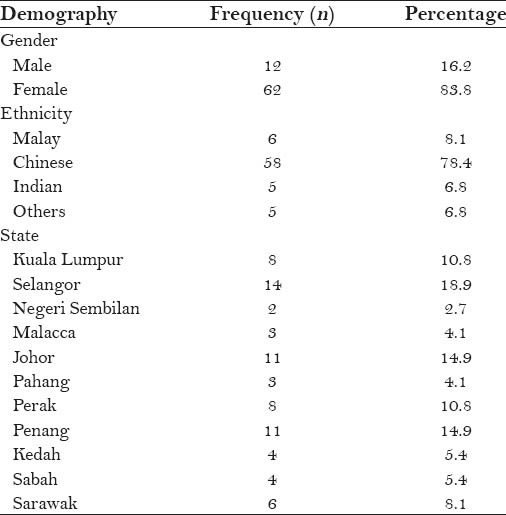
Data analysis revealed that in the knowledge section of the questionnaire, there was almost an equal distribution of right and wrong answers by the students. Among the six questions for knowledge, question 7 (Do you know what is halitosis?) was the least correctly answered question with only 18.9% of students answering it correctly [Table 2]. Also, answers for other knowledge-related questions did not show significant results.
Table 2.
Knowledge toward oral health based on gender, ethnicity, and states of origin

Data analysis showed that in the attitude section of the questionnaire, majority of the students had shown positive attitude toward oral health [Table 3]. 5.4% of students displayed slight negative attitude toward oral health, as these students disagreed that rinsing is necessary to remove food debris after every meal. 1.4% of students displayed slight negative attitude toward oral health, as these students disagreed that sweet sugary food and beverages can cause tooth decay. 5.4% of students displayed slight negative attitude toward oral health, as they disagreed that using fluoride toothpaste strengthens teeth. 4.1% of students displayed slight negative attitude toward oral health as they disagreed that it is necessary to have at least one dental checkup in a year.
Table 3.
Attitude toward oral health based on gender, ethnicity, and states of origin
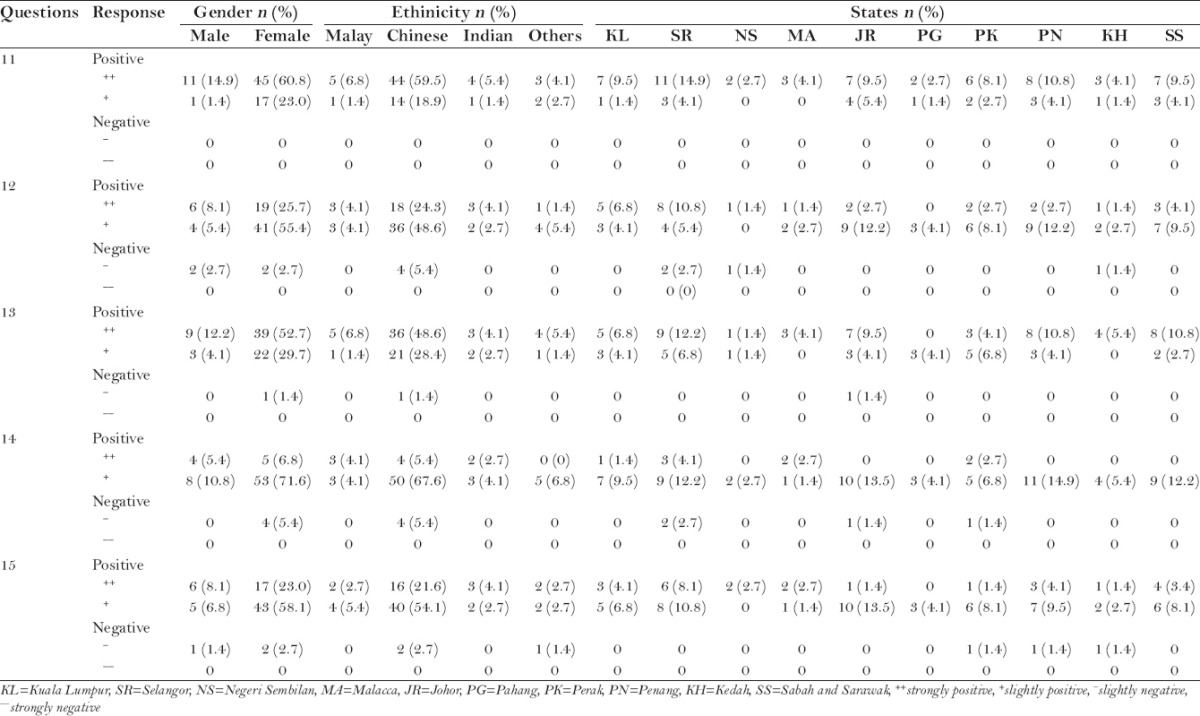
Data analysis revealed that in the practice section of the questionnaire, students had mixed practice principles toward oral health [Table 4]. Among those with encouraging oral health practices, 94.6% brush at least twice a day, 75.7% rinse at least twice a day, and 83.8% of the students use fluoride toothpaste at least 4 times a week. Among those with non-encouraging practices, only 21.7% floss at least 4 times a week, whereas 78.3% floss less than 2 times a week, and only 41.3% of the students used to go for dental checkup at least once a year.
Table 4.
Practice toward oral health based on gender, ethnicity, and states of origin
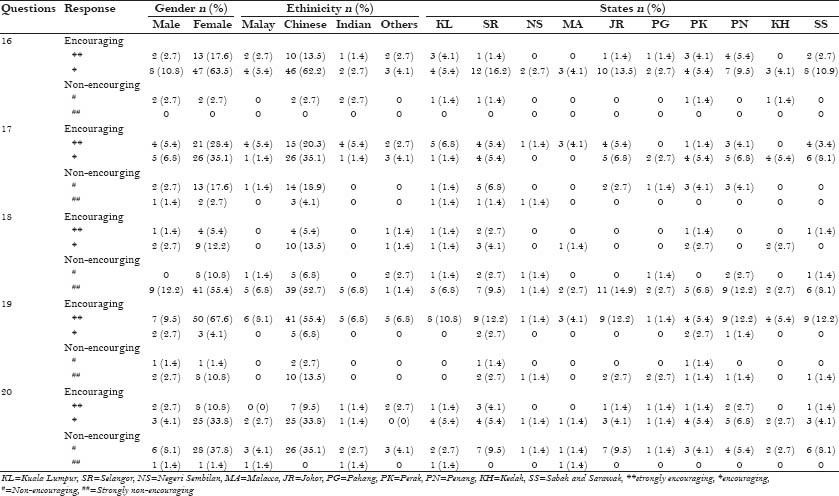
Based on the results obtained, correlation among pharmacy students’ knowledge, attitude, and practice toward oral health was studied [Table 5].
Table 5.
Correlation between pharmacy students’ knowledge, attitude, and practice toward oral health

DISCUSSION
Data analysis on the knowledge section of the questionnaire revealed that there was almost an equal distribution of right and wrong answers by the students. This indicates the lack of oral health knowledge among the pharmacy students, as they were expected to know the answers to all knowledge-related questions. This expectation was absolute as these questions are taught in their curriculum and also represent the common terminology and topics asked by customers to the pharmacists in pharmacies. This result was consistent with that of several studies[11,13,15] which highlighted the lack of topics on oral health education in their curriculum. The minimal interaction between pharmacy students and dental students is also a factor which may be due to the nature of pharmacists, who operate in isolation from the dentists.[1,9]
The positive attitude displayed by the students is consistent with the study by Buxcey et al.,[2] where almost all the pharmacists felt that it was one of their responsibilities to give oral advices to the general public. This result was also consistent with another study by Baseer et al.,[16] where healthcare professionals including pharmacists, doctors, nurses, technicians, and also medical students showed positive attitude toward dental care.
Data analysis of the practice section of the questionnaire revealed that students have mixed practice principles toward oral health. The results obtained were similar to the study by Baseer et al.,[16] where less than 50% of health professionals were found to actually floss their teeth.
There was a significant correlation between students’ knowledge and practice, whereas there was no correction between students’ attitude and practice or between students’ attitude and knowledge. From this it can be interpreted that lack of knowledge does not influence the attitude of the students toward oral health. However, students’ practice toward oral health will make an impact to a certain extent, as knowledge determines one's self-awareness, self-protection, and personal hygiene practices.[17]
Limitation
The present study had some limitations. The present study results were those of pharmacy students attending a private university. So, the results of the study do not represent the entire population of pharmacy students in Malaysia.
CONCLUSION
The findings of this study show that pharmacy students have positive attitude toward oral health despite having poor knowledge and mediocre practice principles regarding oral health. There is a definite need for the students to improve their knowledge as the demand for oral health advices in community pharmacies is increasing.[8,18] There is an edge and awareness of the importance of oral health for them to be competent in giving oral health care advices to the public as part of the primary healthcare team in the near future.
Recommendations
There are several recommendations that may help improve the overall knowledge, attitude, and practice among pharmacy students toward oral health.
Dental health–related seminars, workshops, and inter-professional learning with dental students can be incorporated into the curriculum of pharmacy students to improve their oral health knowledge, attitude, and practice
Further research could be conducted to examine the demand and possibilities of opportunistic oral health advices in community pharmacies, in order to increase the comprehensiveness and expectations of services that could be provided to customers by students in their future career[5]
More workshops and continuing professional development (CPD) recognized oral health courses could be conducted by manufacturers and professional dental organizations in the future to motivate the pharmacists to update their dental knowledge. This is because most pharmacists cannot recall details of the oral health curriculum taught in their undergraduate course.[2]
Footnotes
Source of Support: Nil
Conflict of Interest: None declared.
REFERENCES
- 1.Priya S, Madan Kumar PD, Ramachandran S. Knowledge and attitudes of pharmacists regarding oral health care and oral hygiene products in Chennai city. Indian J Dent Res. 2008;19:104–8. doi: 10.4103/0970-9290.40462. [DOI] [PubMed] [Google Scholar]
- 2.Buxcey AJ, Morgaine KC, Meldrum AM, Cullinan MP. An exploratory study of the acceptability of delivering oral health information in community pharmacies. N Z Dent J. 2012;108:19–24. [PubMed] [Google Scholar]
- 3.Dickinson C, Howlett JA, Bulman JS. The role of the community pharmacist as a dental health advisor. Community Dent Health. 1995;12:235–7. [PubMed] [Google Scholar]
- 4.Gilbert L. The role of the community pharmacist as an oral health advisor – an exploratory study of community pharmacists in Johannesburg, South Africa. SADJ. 1998;53:439–43. [PubMed] [Google Scholar]
- 5.Maunder PE, Landes DP. An evaluation of the role played by community pharmacies in oral healthcare situated in a primary care trust in the north of England. Br Dent J. 2005;199:219–23. doi: 10.1038/sj.bdj.4812614. discussion 211. [DOI] [PubMed] [Google Scholar]
- 6.Scott A, Bond C, Inch J, Grant A. Preferences of community pharmacists for extended roles in primary care: A survey and discrete choice experiment. Pharmacoeconomics. 2007;25:783–92. doi: 10.2165/00019053-200725090-00006. [DOI] [PubMed] [Google Scholar]
- 7.Sheridan J, Aggleton M, Carson T. Dental health and access to dental treatment: A comparison of drug users and non-drug users attending community pharmacies. Br Dent J. 2001;191:453–7. doi: 10.1038/sj.bdj.4801206. [DOI] [PubMed] [Google Scholar]
- 8.Eickhoff C, Verheyen F, Schulz M. Health Promotion in Community Pharmacy: Experiences and Perspectives in Germany. [Last accessed on 2014 Jan 11]. Available from: http://www.univie.ac.at/phc/pics/docs/doc86.pdf .
- 9.Anderson C. Health promotion in community pharmacy: The UK situation. Patient Educ Couns. 2000;39:285–91. doi: 10.1016/s0738-3991(99)00025-7. [DOI] [PubMed] [Google Scholar]
- 10.Iwanowicz SL, Marciniak MW, Zeolla MM. Obtaining and providing health information in the community pharmacy setting. Am J Pharm Educ. 2006;70:57. doi: 10.5688/aj700357. [DOI] [PMC free article] [PubMed] [Google Scholar]
- 11.Chessnutt IG, Taylor MM, Mallinson EJ. The provision of dental and oral health advice by community pharmacists. Br Dent J. 1998;184:532–4. doi: 10.1038/sj.bdj.4809690. [DOI] [PubMed] [Google Scholar]
- 12.Blenkinsopp A, Tann J, Platts A, Allen J. Evaluation of feasibility and acceptability of a community pharmacy health promotion scheme – Views of users and providers. Health Educ J. 2002;61:52–69. [Google Scholar]
- 13.Chestnutt IG, Taylor MM, Mallinson EJ. The provision of dental and oral health advice by community pharmacists. Br Dent J. 1998;184:532–4. doi: 10.1038/sj.bdj.4809690. [DOI] [PubMed] [Google Scholar]
- 14.Freeman R. Barriers to accessing and accepting dental care. Brit Dent J. 1999;187:81–4. doi: 10.1038/sj.bdj.4800208. [DOI] [PubMed] [Google Scholar]
- 15.Omar AB. Knowledge and Attitudes of Pharmacists Regarding Oral Healthcare and Oral Hygiene Products in Riyadh, Saudi Arabia. J Int Oral Health. 2014;6:1–4. [PMC free article] [PubMed] [Google Scholar]
- 16.Baseer MA, Alenazy MS, Alasqah M, Algabbani M, Mehkari A. Oral health knowledge, attitude and practices among health professionals in King Fahad Medical City, Riyadh. Dent Res J (Isfahan) 2012;9:386–92. [PMC free article] [PubMed] [Google Scholar]
- 17.Badran IG. Knowledge, attitude and practice the three pillars of excellence and wisdom: A place in the medical profession. East Mediter Heath J. 1995;1:8–16. [Google Scholar]
- 18.Steel BJ, Wharton C. Pharmacy counter assistants and oral health promotion: An exploratory study. Br Dent J. 2011;211:E19. doi: 10.1038/sj.bdj.2011.938. [DOI] [PubMed] [Google Scholar]


